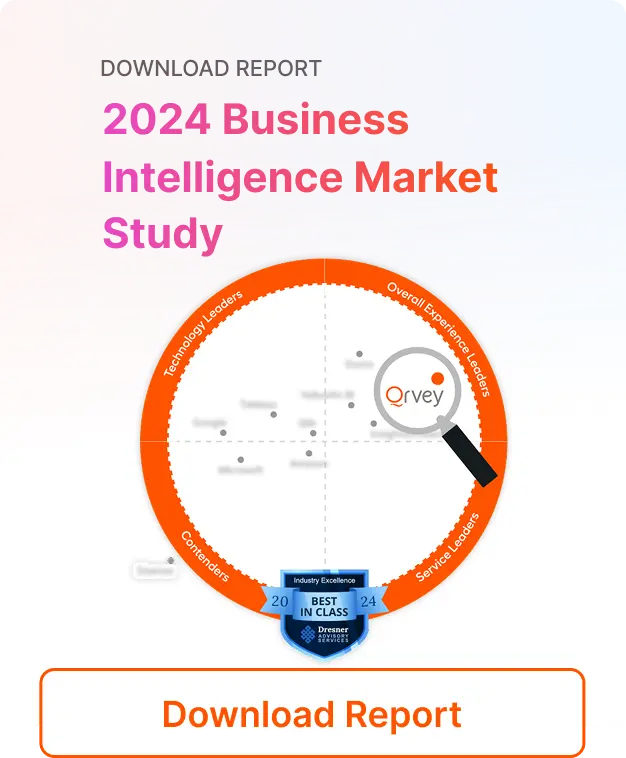
Qrvey Embedded Analytics > What is Augmented Analytics?
What is Augmented Analytics?
Augmented analytics is the use of advanced technologies like artificial intelligence (AI) and machine learning (ML) to enhance data analysis. It automates data preparation, insight discovery, and insight sharing. This technology goes beyond traditional analytics by providing more in-depth, accurate, and timely insights.
For SaaS product managers, augmented analytics is the future of AI in analytics. It allows you to make data-driven decisions faster and more accurately than ever before. By automating complex analytical tasks, it frees up your time to focus on strategic thinking and product innovation.
Table of Contents
Why is Effective Decision-Making Important in a Competitive Market?
In today’s cutthroat SaaS landscape, effective decision-making can make or break a product. It’s crucial for several reasons:

Maximizing Resource Allocation and Minimizing Waste
In the SaaS world, resources are often limited. Augmented analytics helps you allocate these resources more effectively. It provides insights into:
- frequency of feature usage
- which customers are most valuable
- where you should focus your development efforts

Enabling Quick Adaptation to Market Changes and Customer Needs
The SaaS market is dynamic, with customer needs evolving rapidly. Augmented analytics allows you to spot trends early and adapt quickly. This agility can be the difference between leading the market and falling behind.

Providing a Competitive Edge Through Data-Driven Insights
In a crowded market, any edge can be crucial. Augmented analytics gives you deeper insights into your product, customers, and market. These insights can help you differentiate your product and stay ahead of the competition.
Implementing Augmented Analytics in SaaS Products

Integrating AI-Powered Data Analysis Tools into Your Platform
The first step in leveraging augmented analytics is integrating AI-powered analysis tools into your SaaS platform. These tools can automatically process large volumes of data. This allows you to identify patterns and trends that are easy for people to manually miss.

Developing User-Friendly Dashboards for Easy Data Visualization
Data is only useful if it’s understood. User-friendly dashboards make complex data accessible to all stakeholders. They allow for a quick understanding of key metrics and trends at a glance.
Data literacy is a challenge many enterprises face with their analytics programs. When data analysts can simplify data coming from various data sources, the downstream effect is better decision-making. This is one of the key benefits of augmented analytics.

Implementing Automated Reporting Features for Key Performance Indicators
Automated reporting saves time and ensures consistent tracking of important metrics. It allows you to set up regular reports on key performance indicators (KPIs) to analyze data. Having standard dashboards keeps business users in the know without manual effort.
Leveraging Predictive Analytics for Product Development Use Cases

Using Machine Learning Models to Forecast User Behavior Trends
Predictive analytics can help you anticipate user needs before they arise. By analyzing historical data, machine learning models can forecast future trends in user behavior. This is a great way to stay one step ahead.

Implementing A/B Testing with AI-Driven Result Analysis
A/B testing is a powerful tool for product improvement. AI-driven analysis can make this process more efficient and effective. It can quickly process large amounts of test data and provide clear, actionable insights.

Analyzing Feature Usage Data to Prioritize Development Efforts
Not all features are created equal. Augmented analytics can help you understand which features are most valuable to your users. This insight allows you to prioritize your development efforts for maximum impact.
Enhancing Customer Experience with Data-Driven Insights

Utilizing Sentiment Analysis to Gauge Customer Satisfaction
Understanding how your customers feel about your product is crucial. Sentiment analysis can automatically process customer feedback, giving you a clear picture of overall satisfaction and areas for improvement.

Creating Dynamic Pricing Models Using Real-Time Market Data
Pricing can be a complex issue in SaaS. Augmented analytics can help by analyzing market data in real time. These valuable insights allow you to implement dynamic pricing models that maximize revenue while remaining competitive.

Implementing Personalized Recommendations Based on Customer Behavior Patterns
Personalization can significantly enhance user experience. By analyzing user behavior patterns, you can provide tailored recommendations, increasing engagement and satisfaction.
Additional Augmented Analytics Examples

Data Preparation
Data preparation is often the most time-consuming part of analysis. Augmented analytics can automate this process, cleaning and organizing data for analysis. This not only saves time but also reduces the risk of human error.

Data-Driven Workflow Automation
Augmented data analytics can identify patterns in your processes. Workflow automation can streamline those processes, reduce manual work, and increase efficiency.

Self-Service Analytics and Empowering Users to Build Their Own Visualizations
Self-service analytics democratizes data analysis. It allows users across your organization to create their own visualizations and reports. This empowers teams to make data-driven decisions without relying on data specialists.
Extra Tips for Advanced Users for Augmented Analytics

Exploring Natural Language Processing for Intuitive Data Querying
Natural language processing allows users to query data using everyday language. This makes data analysis more accessible to non-technical users, broadening the impact of your analytics efforts.

Implementing Federated Learning for Privacy-Preserving Data Analysis
As data privacy concerns grow, federated learning offers a solution. It allows you to gain insights from data across multiple sources without compromising individual privacy.

Developing AI-Powered Anomaly Detection for Proactive Issue Resolution
Anomaly detection can alert you to potential issues before they become problems. This proactive approach can improve product stability and user satisfaction.

Harnessing the Power of Augmented Analytics with Qrvey
Augmented analytics is not just a buzzword. It’s a powerful tool that can transform how SaaS product managers make business decisions and drive product success.
Qrvey’s embedded analytics platform is at the forefront of this revolution. We bring the power of AI through augmented analytics directly to users of SaaS platforms. With Qrvey, you can easily integrate advanced analytics capabilities into your product.
You’ll be offering users powerful insights without the need for complex data science skills in no time.
Qrvey’s solution is a seamlessly integration into your SaaS platform. Product leaders can offer
- automated data preparation
- self-service analytics solutions
- AI-driven insights
This not only enhances your product’s value proposition but also empowers your users to make better, data-driven decisions.
In the competitive SaaS landscape, augmented analytics is no longer a luxury—it’s a necessity. And with Qrvey, you can harness its full potential. Drive your product forward, enhance user experience, and stay ahead of the competition.
The future of SaaS is relies on data, and with augmented analytics, you’re ready to lead the way.
To learn more about how AI impacts analytics solutions, listen to our webinar with our CTO David Abramson. He will discuss the role of generative AI in embedded analytics and share his thoughts and predictions.
Analytics for Those Who Want More
Build Less Software. Deliver More Value.
More Insights
Why is Multi-Tenant Analytics So Hard?
BLOG
Creating performant, secure, and scalable multi-tenant analytics requires overcoming steep engineering challenges that stretch the limits of...
Pricing Strategies to Maximize Revenue from Analytics
GUIDE
Unlock the full potential of your SaaS business with our comprehensive guide on pricing and packaging strategies.
How JobNimbus deployed Qrvey to 6,000 customers
CASE STUDY
Discover how JobNimbus deployed Qrvey to 6,000 customers and saw an immediate reduction in customer churn....








